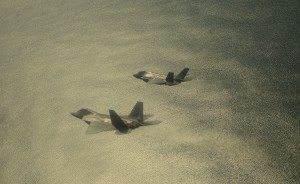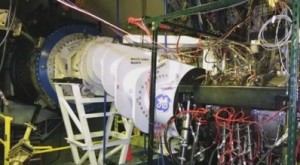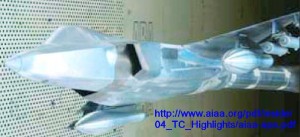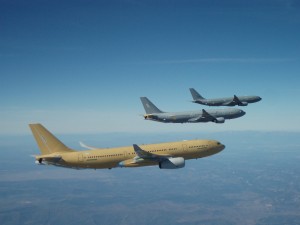2014-01-15 By Michael W. Wynne
21st Secretary of the United States Air Force
Welcome to a new year in the world of design and development of Air Superiority; and therefore Concepts of Air Warfare.
Over the past several years, while the United States was unilaterally giving up its clear advantage with the F-22 and delaying the emergence of the Next Generation Bomber, good progress was being made on the remainder of its investment.
The Tanker Competition continued with an American winner, the KC-46, and the European winner, the A330 MRTT, with sales to Australia, Britain, India, Saudi Arabia, and the UAE has introduced new generation tanking globally.
New tankers are not simply new flying gas cans in the sky. They are part of the changing concepts of operations.
The concept of tanker refueling and range extension through the evolution of tanker operational concepts will have significant impacts as well on shaping the emergence of new concepts in Air Warfare.
The remaining fifth generation fighter, the F-35, while facing an uncertain future within the terrible budget environment in the United States, has received ringing endorsements from the international partners; and inquiries from non-partners as to how they could become partners.
This burst of confidence bolstered the budgeting process in all three services; as the top pilots for each acknowledged that the supremacy of the F-22 and the F-35 leave little doubt as to what they want to meet a determined competitor in the future.
As more and more terrific pilots are introduced to the flying and battle characteristics of the fifth generation fleet this good ‘virus’ appears to be spreading to the international Air Forces. Where possible, the services are reaching into their kit bags to find ways to maintain the excellent fourth Generation fighter capability; and find ways to better integrate their inherited fleets.
This will undoubtedly extend to major coalitions; as we begin to talk about multinational Air Fleets with multi generational capabilities.
Key Elements for a Way Ahead
The Next Generation Bomber Investment continues apace with rumors of RADAR extended range. There is also a new generation of propulsion capability as well which underscores that there is no lack for innovation; though that must be followed by funding with the right rigor and encouraging persistence and patience.

It needs to be remembered that our Strategic Forces continue to age pointing towards one hundred years of peaceful deployment of the B-52 and the Minuteman from their first invention. Recalling that neither the B-1 nor the B-2 achieved large fleet status; some wonder if America has the will to continue to have air dominance.
Just last year our Air Force lost a single B-2; but there was no mention in the covering press that this was more than five percent of the entire fleet.
But these three – F-35, tankers, and the next generation bomber — merit the prized status of being the top three priorities for the Chief of Staff; and well they should be. Though there have been ignominious calls for disbanding our Air Force; this would clearly be in the best interest of our world competitors, at the expense of the future freedom of our Nation.
Even before a season had passed after one US Defense Secretary stated there would be no fifth generation competitor, one flew over his head in China; and they are not alone in pushing the state of the art.
Now it has been reported that these same great engineers in the PRC are in pursuit of a Hypervelocity Missile.
Clearly underestimating potential competitors can have serious or even fatal consequences.
As one World War ll General stated; when they kick your tail in Air Combat; there’s no stopping at their border, nor yours. Even Sir Winston Churchill got in on the act with a quote ‘Your either own the Skies; or cower under those that do’.
We retain the capability to power project vertical lift anywhere in the Pacific with the Osprey/KC130J combination clearing the way for a force such as the Marine Air-Ground Task Force to operate faster than before; and the Marines are talking of enhancements.
The United States retains three great positives in the quest to continue down the path of air dominance.
First; we retain the technological edge in our fifth generation fighter, and the push for the Next Generation Bomber.
Second; we have terrific international friends who will share the burden of maintaining a peace and are actively into sharing targeting information. They are also co-investing significantly in the F-35 program and building manufacturing facilities as well for the program.
Third, we remain innovative throughout all of our Air Power elements.
Additives to the Fifth Generation Enabled Fleet
Let us now consider what changes in equipage which are not costly and are relatively minor can have a major impact on shaping future American air superiority.
The United States recently gave up additional combat margin as it stood down fighter training and let our systems age and atrophy. This likely went unnoticed by the American Public, but our competitors were each calculating both the initial impact and the time to recover.
Ever since the massive assault on Pearl Harbor, the question has been raised as to how fast America can recover from damage from external or internal sources.
But, we must assume that there was discussion within the governing community as the impact is already being worked on; and we have also had Airmen die in accidents, which should bring pause to further training standdowns.
During a recent phase in the Syrian crisis, the prospect of putting in place a no fly zone was suggested by some. But there is growing lack of enthusiasm for providing no-fly zones among airpower professionals due to the continued proliferation of integrated air defense systems.
Designers of integrated air defenses are very excited about the prospects for air denial. They are continuing to range extend, to enhance the accuracy and designed detection capability and to proliferate their inventions.
We see this extend to keep out zones well into international areas of commerce much as the Libyans had tried to do with their declaration many years ago of a keep out zone in the Mediterranean Sea bordering their Nation. This effort is a mirror image of previous centuries Naval Blockade.
The question becomes: What constitutes a response?
The obvious impact is to increase range notice such that there increases the possibility of detection and determined response. As it happens; there has been an historical response to this very concept.
The response has to imagine the capability essentially to shrink any battlespace to its elements of engagement and detection; while maintaining the ability to maneuver forces to weakened areas.
This requires Air Elements to maximize their fuel supply just prior to entering any engagements.
Historically, there emerged a need to use drop tanks to allow for sleek designs for fighters which quickly merged into concepts to simply range extend for escort duty, allowing the same outcomes that we fundamentally seek today.
The goal is deeper penetration into zones of exclusion than would be allowed by fuel inspired range constraints.
We have seen that competitor Air Forces have grown their fighter aircraft bigger, which allows for greater fuel capacity and thus greater range. Though we have as well grown our fighter aircraft bigger, it is for greater internal stores and an insistence on stealth.
The baseline for combat radius is found in declarative charts depicting the characteristics for the F-35 versions; and is presently 584 for the CTOL; 469 for the STOVL and 615 for the Carrier Version; all expressed in Nautical Miles.
To attentuate the physical constraint of range, there are two distinct fighter pursuits.
First, one can invent an engine that will yield better gas mileage. This has been the pursuit of all propulsion engineers, and has yielded gradual improvements in design; and results in allowing better fuel policies.
Mirroring commercial engine development, we have seen upwards of fifteen percent improvement since the development days of the F-35 and the F-22 engines. Of course it is very difficult to make propulsion change decisions. Though we find a military version within the propulsion directorate of the Air Force Research Laboratory, there has yet to be enough merit to push for a model change.
A fifteen percent impact would expand the combat radius yielding 672 for CTOL; 539 for the STOL; and 707 for the Carrier Version.

http://www.gizmag.com/ge-advent-hottest-jet-engine-less-gas/26447/
Engineers at GE think they could have a revolution on their hands, thanks to the new jet engine they’ve been testing recently that runs hotter than any of its predecessors. When combined with some other design changes, they figure their so-called ADVENT (short for ADaptive Versatile ENgine Technology) design could improve fuel efficiency by as much as 25 percent extend flying ranges by 30 percent, and boost thrust up to 10 percent over contemporary engines.
Second, one could return to a drop tank design that was in vogue up to 2004 for the F-35 but set aside in light of the myriad hard problems being solved simultaneously to get through testing.
By that time they had settled on a extended pylon and tank design for a 426 gallon tank on each wing yielding a combined 852 Gallon range extension capability.

http://www.aiaa.org/pdf/inside/04_TC_Hi … aa-apa.pdf
The calculations, neglecting range drag, could yield an additional range of 372 Nautical Miles, which are directly additive to any other radius improvement; and therefore adds more value to the STOVL.
While this is all a good thing and begins dramatically to reduce standoff distances that are now cropping up as keep out zones, this must return to engineering for restoring stealth characteristics.
Standoff distances are best reduced by destroying any integrated defenses along a corridor that would allow Carrier intervention; or occupation of a land mass.
This follows Macarthur’s strategy in the Pacific and Mark Clark’s strategy in the Italian campaign; and more recently Moseley’s strategy in the Middle East. To get these effects however with all the technical improvement will involve the direct involvement of fifth generation in the offensive engagement team, to identify targets and in some instances attack critical elements of the then enemy integrated infrastructure.
This means that when the forces arrive at the point of penetration, the requirement is that they should have maximum fuel availability and be as stealthy as possible to accomplish their mission.
These available, but not yet released additions to not only the US Air Elements but all of those partner nations yield the following:
| F-35 Version | Base Combat Radius | With Drop Tanks | With Enhanced Engine |
| CTOL | 584 NMI | 770 NMI | 885 NMI |
| STOVL | 469 NMI | 655 NMI | 753 NMI |
| CV | 615 NMI | 801 NMI | 921 NMI |
While not easy alternatives, one can easily see the advantages of such investments to ensure that the essence of our deterrent strategy articulated long ago by Gen LeMay to hold hostage any point on the planet is maintained in 21st century conditions.
Curtis LeMay knew from experience that with a combination of ISR and Precision Weapons, target detection and identification would become important; but could not have imagined that we would consider using Air Power assets as scouts (a key way to understand a key role for 5th generation aircraft) leading the way to indirect and supporting weapons fire.
This is our state of play as we approach the second century of Air Power; but on the way to designing for the deterrent mission we have pushed the state of the art in tanker design and concepts of operation.
The Impact of the Tanker
I was recently privileged to spend time with the Commander of AMC; and we talked of emerging elements in future. First the interoperable nature of the competing modern Air Refueling Tankers, the American KC-46; and the European A330 MRTT, as they were both designed to American and NATO standards.
Such interoperability in new tanker aircraft will allow the collaboration of fleets to dispense fuel across the coalition and reinforce the concept of a multi-nation, Air Equivalent to Admiral Mullen’s 1000 ship Navy.

This will allow coalition forces to bring to bear at a point of penetration significant resources to carry the offensive enterprise through its mission.
Second was the extensible nature of the mission, due to the ability to offload fuel onto a partner aircraft.
While this has a degree of flexibility, there are other dimensions, such as sending multiple tankers to a point of departure; and reloading empties to remain on station awaiting a returning fleet. The tanker fleet could very well be protected by fourth generation fighters as they would be vulnerable targets.
But coupled with the previously discussed range extenders, employing these future concepts of operations among the collected coalition members would provide tremendous maneuver space making any proposed defense a 360-degree requirement for a intended combatant nation.
In short, what is next in Concepts of Air Warfare is a combination of back to the future in recalling historical usage of drop tanks, though tied to a strict ability to re-stealth the fifth generation aircraft; an injection of new propulsion technology to gain maximum range from the engine; and finally a change in thinking that may always be hardest that the new refuelable Tankers are bringing to the logistics of Air Dominance.
Expanding the maneuver space, as the Germans did in avoiding the Maginot line; and as MacArthur did in his island hopping scheme continues to foster the straight forward deterrent philosophy that the best defense is a potent offensive enterprise; and the best offensive enterprise is one that never has to be used in battle.
Editor’s Note: There is clear interest in shaping the drop tank approach for the F-35 from Israel. A key advantage of the F-35 global enterprise is that innovations in one part of the eneterprise can be adopted by others in that enterprise.
In August 2012 Lockheed Martin received a $206 million award from the U.S. Navy Naval Air Systems Command, covering the development and integration of Israeli systems in the F-35A. Part of a larger package, the integration support agreement with Lockheed Martin covers a $450 million program to enhance Electronic Warfare (EW) equipment on the F-35, and integrate Israeli-unique systems beginning in 2016.
“The advantage of this F-35 for the Israel air force is not about higher performance or a specific weapon capacity, but the ability to understand the battlespace, identify, locate targets from standoff range and neutralize them before being engaged,” Brig. Gen. Hagi Topolanski, Chief of Air Staff and Deputy Israeli Air Force Commander, told Aviation Week in a recent interview….
…To further extend the F-35’s range, Lockheed Martin is exploring an innovative concept from Israel, of using unique drop tanks, developed by Elbit Systems Cyclone. Designed in a similar concept to the F-22 under-wing drop tanks, these tanks, each containing 425 gal. of fuel, will use special attachment pylons that would completely separate from the wing, regaining full stealth capability after separation. An additional 900 gal. of fuel will significantly extend the F-35I range, enabling the IAF to operate its new stealth fighter at the “outer ring” of operation without mandatory aerial refueling.”
http://ontheroger.proboards.com/thread/4933

